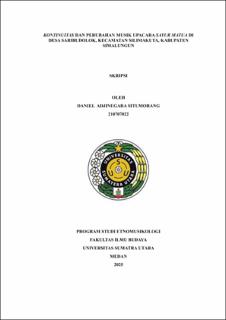| dc.contributor.advisor | Rithaony | |
| dc.contributor.advisor | Gulo, Hubari | |
| dc.contributor.author | Situmorang, Daniel Adjinegara | |
| dc.date.accessioned | 2025-08-04T07:52:45Z | |
| dc.date.available | 2025-08-04T07:52:45Z | |
| dc.date.issued | 2025 | |
| dc.identifier.uri | https://repositori.usu.ac.id/handle/123456789/108003 | |
| dc.description.abstract | This study aims to describe the continuity and changes that occur in the
Sayur Matua traditional ceremony in the Simalungun tribe, precisely in Saribu
Dolok Village, Silimakuta District, Simalungun Regency. The Sayur Matua
ceremony is a traditional activity of the Simalungun tribe carried out for parents
who have passed away. This ceremony is a sacred activity for the Simalungun tribe,
because this activity is a final respect for the Simalungun tribe who have reached
the desired age and have completed their duties in this world. This research is
descriptive qualitative and the method used by researchers is participatory
observation and in-depth interviews with informants, field observation and
documentation. Researchers found that there were changes that occurred in this
Sayur Matua ceremony. Both in terms of musical instruments, the repertoire
presented then there were several significant changes from the event for example
there was a change in terms of the use of Gonrang Sipitu-pitu which was previously
used in every Sayur Matua ceremony but currently only the descendants of the King
use Gonrang Sipitu-pitu. The performance of the repertoire, which was previously
used, such as Gual Rambing-rambing and Gual Olop-olop, is no longer used in the
Sayur Matua ceremony. Continuity is maintained in the Sayur Matua ceremony,
including the stages of the ceremony, such as the use of Porsa, Indahan Baluton,
Tombuan, and the Tolu kinship system of sahundulan lima saodoran. The theory
used by the author supports Kingsley Davies' theory of change and continuity, Alan
P. Merriam's theory of the 10 functions of ceremonies, Koentjaraningrat's theory of
the concept of ceremonies, and Bruno Netll's theory for analyzing music. | en_US |
| dc.language.iso | id | en_US |
| dc.publisher | Universitas Sumatera Utara | en_US |
| dc.subject | Continuity | en_US |
| dc.subject | Sayur Matua | en_US |
| dc.subject | Death Ceremony | en_US |
| dc.title | Kontinuitas dan Perubahan Musik Upacara Sayur Matua di Desa Saribudolok, Kecamatan Silimakuta, Kabupaten Simalungun | en_US |
| dc.title.alternative | Continuity and Change in the Sayur Matua Ceremonial Music of Saribudolok Village, Silimakuta District, Simalungun Regency | en_US |
| dc.type | Thesis | en_US |
| dc.identifier.nim | NIM210707022 | |
| dc.identifier.nidn | NIDN0016116305 | |
| dc.identifier.nidn | NIDN0021067203 | |
| dc.identifier.kodeprodi | KODEPRODI91201#Etnomusikologi | |
| dc.description.pages | 119 Pages | en_US |
| dc.description.type | Skripsi Sarjana | en_US |
| dc.subject.sdgs | SDGs 11. Sustainable Cities And Communities | en_US |


